Oremus
by
Terry Sullivan
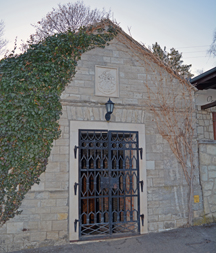 Summary: The word Oremus is Latin for, “Let us pray.” It is the name of the vineyard where the Oremus winery harvests its grapes. Vineyards have been planted on the Oremus site for centuries. During the 13th century, the Roman Catholic Pauline order established the vineyard and called it Oremus. Across from the modern winery building, entrances to cellars dot the landscape. Today the Oremus winery still cultivates the vineyards and produces dry wines, and the liquid sunshine of Aszü and Eszencia.
Summary: The word Oremus is Latin for, “Let us pray.” It is the name of the vineyard where the Oremus winery harvests its grapes. Vineyards have been planted on the Oremus site for centuries. During the 13th century, the Roman Catholic Pauline order established the vineyard and called it Oremus. Across from the modern winery building, entrances to cellars dot the landscape. Today the Oremus winery still cultivates the vineyards and produces dry wines, and the liquid sunshine of Aszü and Eszencia.
The Oremus winery’s parent company is Tempos Vega Sicilia who owns wineries in Ribera del Duero and Toro in Spain and Oremus in Tokaj, Hungary. Oremus owns 250 acres of vineyards in 10 different parcels. About half of the 15-acre Oremus vineyard parcel is planted with Furmint. The other half has plantings divided amongst Hárslevelü, Zeta and Sárga Muskotály (Muscat Blanc à Petits Grains). There are a few parcels of Kövérszőlő and Gohér.
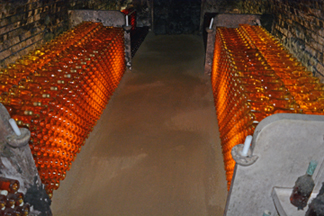 Cellar
Cellar
Upon arriving at Oremus, we met Szabolcs Ujfalussy who gave us a tour of the cellar, production area and conducted our wine tasting. Not only is the Oremus vineyard in Tokaj an area where grapes have been planted for centuries; the cellars are also old and date from the 12th and 13th centuries. Much of the arched ceiling is covered in black cellar mold, a natural humidifier in the cellars. Hungarian barrels and wine bottles line the walls. Barrels may be used for five years. The wine bottles show off their gold to orange colors in this dark environment. Emerging from the cellars, that maintain a constant 11°C - 12°C (52°F - 54°F), we walked across the road to the winery production building.
Winery Production
Our first stop was outside, overlooking the village with grapevines on the slopes of the hills beyond the village. Next to the building, four boxes have soil samples from the vineyards. Close to these boxes rocks from the vineyards showcase the terrain of the vineyards.
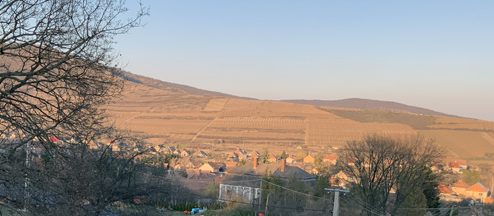
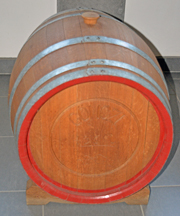 Inside the building, stainless steel tanks stand in lines fermenting or aging wines. On another level, photos of grape clusters show the evolution of grapes from ripe to botrytized. It is on this level that we see puttonyos and gönci barrels. A puttony is a wooden basket used for placing harvested grapes and carried on a person’s back. The gönczi barrel is a 136 liter oak barrel used for aging Aszü wines. Prior to modern chemistry where winemakers can test the amount of sugar in a wine, Aszü wines were made by blending five or six puttonyos with the must in a gönci barrel. Thus the Aszü wine would bear the word 5 puttonyos or 6 puttonyos on the label. These two terms are still in use today and they quickly tell the consumer the level of sweetness in this delicious dessert wine.
Inside the building, stainless steel tanks stand in lines fermenting or aging wines. On another level, photos of grape clusters show the evolution of grapes from ripe to botrytized. It is on this level that we see puttonyos and gönci barrels. A puttony is a wooden basket used for placing harvested grapes and carried on a person’s back. The gönczi barrel is a 136 liter oak barrel used for aging Aszü wines. Prior to modern chemistry where winemakers can test the amount of sugar in a wine, Aszü wines were made by blending five or six puttonyos with the must in a gönci barrel. Thus the Aszü wine would bear the word 5 puttonyos or 6 puttonyos on the label. These two terms are still in use today and they quickly tell the consumer the level of sweetness in this delicious dessert wine.
Current production at Oremus is 200,000 bottles. The winery plans to increase production to 300,000 bottles within five years, mainly due to the dry Furmint which is called Mandolas. The first attempt to produce high quality dry wine was in 1997 at Oremus.
Eszencia
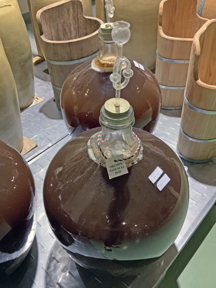 We also observed clear glass demi-johns of the 2018 Eszencia slowly fermenting. Behind the glass containers in the photo are the puttonyos. Szabolcs explained that Eszencia is the free run juice of botrytized grapes placed in a large container. The free run juice is made into a wine without adding it to other wine, must or juice. The resulting wine is very low in alcohol, often between 2% and 3% alcohol and very high in sugar content, up into the 500s g/L of residual sugar. Airlocks enclosed the demijohns. The wine ferments very slowly over weeks. The fermentation may stop and then begin again. This can continue for a lengthy period. When the winemaker decides to bottle the Eszencia, the wine undergoes a sterile filtration and finally bottled. The sterile filtration process removes the yeast cells, so that the wine cannot continue to ferment once bottled.
We also observed clear glass demi-johns of the 2018 Eszencia slowly fermenting. Behind the glass containers in the photo are the puttonyos. Szabolcs explained that Eszencia is the free run juice of botrytized grapes placed in a large container. The free run juice is made into a wine without adding it to other wine, must or juice. The resulting wine is very low in alcohol, often between 2% and 3% alcohol and very high in sugar content, up into the 500s g/L of residual sugar. Airlocks enclosed the demijohns. The wine ferments very slowly over weeks. The fermentation may stop and then begin again. This can continue for a lengthy period. When the winemaker decides to bottle the Eszencia, the wine undergoes a sterile filtration and finally bottled. The sterile filtration process removes the yeast cells, so that the wine cannot continue to ferment once bottled.
Wines
Production is focused on producing the Tokaj sweet wines; however, about 12 years ago they began thinking about also producing dry wines. Szabolcs noted that the sweet wine market is stabilizing, while the dry wine market is increasing.
After the winery tour, we proceeded to the tasting room where we tasted five wines in the Oremus portfolio. The 2017 Mandolás was a dry Furmint. The grapes were from Oremus’ Mandolás vineyard. The light yellow colored wine had 13% alcohol. The aroma was light with flowers and tropical fruits. The taste was mostly citrus and the finish was crisp.
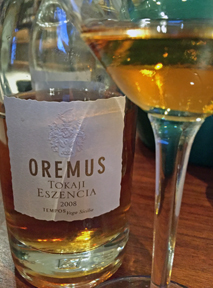 The 2016 Late Harvest was crafted with mostly Furmint and Hárslevelü. Added to the blend was a splash of Sárga Muskotály and Zeta. The wine was six months in barrel. The bright gold colored wine had 12% alcohol, 110 g/L of residual sugar and 8.2 g/L acidity. Jammy fruits and honeysuckle were on the aroma. The taste was reminiscent of peach jam and honeysuckle with a smooth mouthfeel. The finish was crisp.
The 2016 Late Harvest was crafted with mostly Furmint and Hárslevelü. Added to the blend was a splash of Sárga Muskotály and Zeta. The wine was six months in barrel. The bright gold colored wine had 12% alcohol, 110 g/L of residual sugar and 8.2 g/L acidity. Jammy fruits and honeysuckle were on the aroma. The taste was reminiscent of peach jam and honeysuckle with a smooth mouthfeel. The finish was crisp.
We tasted two Aszü wines, one with a sugar level at 5 puttonyos and the other with a sugar level of 6 puttonyos. The 2009 Aszü 5 puttonyos was a gold color. The wine, with 11% alcohol, had 148 g/L of residual sugar and 9 g/L acidity. Dried fruits were noticed on the aroma. The velvety mouthfeel had an apricot, honeysuckle and citrus taste. The finish was fruity.
In contrast the 2007 Aszü 6 puttonyos was a dark gold color. The 10% alcohol wine had 214 g/L of residual sugar and 9.4 g/L acidity. Dried fruits were on the aroma while the taste included dried apricots and honeysuckle. The mouthfeel was very velvety. The finish was fruity with a very long aftertaste of dried apricots.
The 2008 Eszencia was an amber color wine with 3% alcohol. It had 504 g/L of residual sugar and 16 g/L acidity. The wine’s aroma was of dried fruits and flowers. The wine had a very thick velvety mouthfeel. Dried apricots and honey were on the taste and the finish was sweet and fruity. The wine had an extremely long aftertaste. This wine is in the $300 range for a 375 ml bottle. Very few bottles of Eszencia are made and only produced during very good years. Use the wine over ice cream or pancakes or enjoy slowly as an aperitif.
We enjoyed tasting the wines and the tour, especially tasting and learning about unique Eszencia. Although the winery building is modern, the cellar system is old and you feel as though tradition has not been forgotten by Oremus.
Oremus
Tolcsva, Bajcsy-Zsilinszky Endre utca 45, 3934 Hungary
Article written April 2019.
Please support the following Hungarian wineries and wine tour company.
| Wine a'More Travel |



